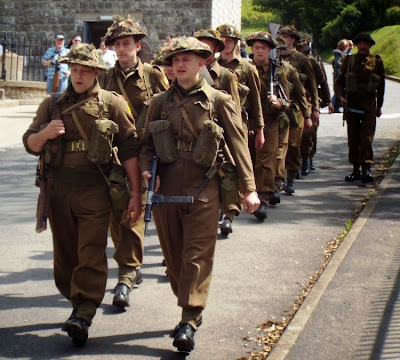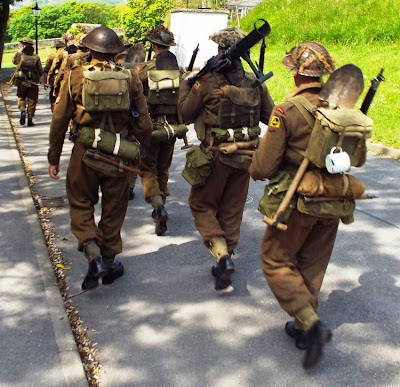Sue and I are members of the National Trust and English Heritage, and have been members of both organisations for quite a long time. Now that we are retired, we hope to spend more of our time visiting the various places that these two bodies help to maintain ... and yesterday we visited Dover Castle.
Sue had spotted that English Heritage was hosting a World War II event at Dover Castle over this Bank Holiday weekend, and we decided to go yesterday (Sunday) as we expected that it to be less crowded than it would be on the Bank Holiday Monday. It took us less than ninety minutes to drive to Dover, and after parking in one of the nearby overflow car parks, we arrived at the entrance just before 11.00am. Thanks to having bought tickets online before we left home, we were able to avoid the queues at the ticket office and walked straight in.
We entered the Castle
via the Constable's Gate ...
... and turned right towards the sea. As we walked along the pathway towards the NAAFI Restaurant, we had a magnificent view over the port and town of Dover.
Away from the ferry port, we could see a cruise liner moored alongside the Cruise Terminal. (The ship was the
AIDA Sol).
A number of re-enactors had set up displays next to the path. They were from a group called
Das Heer and represent member of the 27th Infantry Regiment of the 12th Infantry Division.
We decided to have a drink outside the NAAFI Restaurant, and whilst we were there we had to opportunity to spend some time looking at a group of re-r actors who were depicting life on the Home Front during the Second World War.
We had intended to visit the wartime tunnels and the Operation Dynamo exhibit, but the queue was so long (it was estimated that we would have to have queued for between one and two hours to get in) that we decided to move on towards the Admiralty Look-Out and Coastal Artillery Fire Control Station. Along the way we were passed by a group of re-enactors dressed as members of the Essex Regiment.
We also passed a statue of Admiral Ramsey (the man who organised and commanded the evacuation of Dunkirk and helped to plan Operation Overlord) that was situated looking out across the English Channel ...
... and a 3-inch anti-aircraft gun.
The Admiralty Look-Out and Coastal Artillery Fire Control Station was very impressive, and made an interesting comparison with similar German bunkers we have visited on Jersey.
The view from the top of the building was very impressive, and it was interesting to see the White Cliffs from a somewhat different angle from normal.
We then made our way up the steps towards the old Officers Mess ...
... and along the roadway that passes around the mound on top of which is the church of St Mary-in-Castro ...
... and past some old artillery casemates.
Das Heer was mounting a display in the natural amphitheatre between the Great Tower and the church mound. They demonstrated the various weapons used by the Wehrmacht...
... and despite warnings a lot of people were taken aback by the noise generated by blank-firing weapons.
Another re-enactment group was also present at the display but we're not taking part. They represented the French Army, and included members who were dressed as North African troops.
We retraced our steps around the church mound, and made our way through Peverell's Gate ...
... and into the area that is usually used as a car park for Disabled Blue Badge holders. This contained a number of stands and exhibits, amongst which was an RAF exhibit that included a replica Supermarine Spitfire.
We then walked back past The Constable's Gate towards the entrance to the Medieval tunnels. Two re-enactment groups were situated there, one of which represented the Essex Regiment ...
... and the other recreated the German Home Front.
As it was past midday and the Castle was getting increasingly crowded we decided to call it a day and return home. A minibus took us back to the car park just in time to see a Hawker Hurricane perform a display overhead. (It was actually a Hurribomber as it was specially equipped to act as a fighter-bomber rather than as an interceptor.)
Our journey home took just over ninety minutes, and both of us felt that the event had been very interesting and very entertaining ... and an excellent way to spend a sunny Sunday.

























































































.jpeg)












